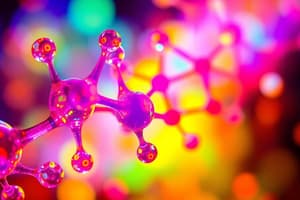Podcast
Questions and Answers
What does absorption spectroscopy primarily measure?
What does absorption spectroscopy primarily measure?
- Mass-to-charge ratios of ions
- Fluorescence emitted after light absorption
- Wavelengths of light absorbed by a substance (correct)
- Energy emitted by a substance
Which type of spectroscopy is specifically used to analyze the emitted light from a substance?
Which type of spectroscopy is specifically used to analyze the emitted light from a substance?
- Fluorescence Spectroscopy
- Nuclear Magnetic Resonance Spectroscopy
- Raman Spectroscopy
- Emission Spectroscopy (correct)
What technique utilizes mass-to-charge ratios to analyze ionic composition?
What technique utilizes mass-to-charge ratios to analyze ionic composition?
- Absorption Spectroscopy
- Emission Spectroscopy
- Mass Spectrometry (correct)
- Fluorescence Spectroscopy
In which practical application is NMR (Nuclear Magnetic Resonance) spectroscopy primarily used?
In which practical application is NMR (Nuclear Magnetic Resonance) spectroscopy primarily used?
What does the Beer-Lambert Law describe in the context of spectroscopy?
What does the Beer-Lambert Law describe in the context of spectroscopy?
What is the primary purpose of a spectrometer?
What is the primary purpose of a spectrometer?
Which aspect of light does the term 'wavelength' refer to?
Which aspect of light does the term 'wavelength' refer to?
Raman spectroscopy provides information about which of the following?
Raman spectroscopy provides information about which of the following?
Flashcards are hidden until you start studying
Study Notes
Overview of Spectroscopy
- Spectroscopy is the study of the interaction between light and matter.
- It analyzes the spectrum of light emitted, absorbed, or scattered by materials.
Types of Spectroscopy
-
Absorption Spectroscopy
- Measures the wavelengths of light absorbed by a substance.
- Useful for determining concentration and structure.
-
Emission Spectroscopy
- Analyzes the light emitted by a substance.
- Often used in flame tests and analyzing elements.
-
Fluorescence Spectroscopy
- Studies the fluorescence emitted by a substance after absorption of light.
- Highly sensitive, applicable in biological studies.
-
Raman Spectroscopy
- Based on inelastic scattering of monochromatic light (usually from a laser).
- Provides information about molecular vibrations, chemical composition.
-
Mass Spectrometry
- Analyzes ions to determine molecular mass and structure.
- Different from traditional spectroscopic techniques, utilizes mass-to-charge ratios.
-
Nuclear Magnetic Resonance (NMR) Spectroscopy
- Explores magnetic properties of atomic nuclei.
- Provides detailed information about the structure of organic compounds.
Applications
- Chemical Analysis: Identifying and quantifying substances.
- Astronomy: Understanding the composition of stars and galaxies.
- Environmental Monitoring: Detecting pollutants and studying atmospheric processes.
- Medicine: Diagnostics and therapeutic monitoring (e.g., MRI uses NMR).
Basic Principles
- Wavelength: Distance between successive peaks in a wave; affects color and energy.
- Frequency: Number of waves that pass a point per second; inversely related to wavelength.
- Energy: Proportional to frequency; higher frequency = higher energy.
Instruments
- Spectrometer: Device for measuring properties of light in a spectrum.
- Monochromator: Isolates individual wavelengths of light.
- Detector: Measures intensity of light at each wavelength (e.g., CCD, photomultiplier tube).
Key Concepts
- Beer-Lambert Law: Relates absorbance to concentration and path length.
- Spectrum: A plot of intensity vs. wavelength (or frequency).
- Resolution: Ability to distinguish between different wavelengths; crucial for accurate analysis.
Overview of Spectroscopy
- The study of how light interacts with matter
- Analyzes the spectrum of light emitted, absorbed, or scattered by materials
Types of Spectroscopy
- Absorption Spectroscopy: Measures the wavelengths of light absorbed by a substance
- Determines substance concentration and structure
- Emission Spectroscopy: Analyzes the light emitted by a substance
- Applications include flame tests and elemental analysis
- Fluorescence Spectroscopy: Studies the fluorescence emitted by a substance after absorbing light
- Highly sensitive, used in biological studies
- Raman Spectroscopy: Based on inelastic scattering of monochromatic light (usually from a laser)
- Provides information about molecular vibrations and chemical composition
- Mass Spectrometry: Analyzes ions to determine molecular mass and structure
- Utilizes mass-to-charge ratios
- Nuclear Magnetic Resonance (NMR) Spectroscopy: Explores the magnetic properties of atomic nuclei
- Provides detailed information about the structure of organic compounds
Applications
- Chemical Analysis: Identifying and quantifying substances
- Astronomy: Understanding the composition of stars and galaxies
- Environmental Monitoring: Detecting pollutants and studying atmospheric processes
- Medicine: Diagnostics and therapeutic monitoring (e.g., MRI uses NMR)
Basic Principles
- Wavelength: Distance between successive peaks in a wave
- Affects color and energy
- Frequency: Number of waves that pass a point per second
- Inversely related to wavelength
- Energy: Proportional to frequency
- Higher frequency = higher energy
Instruments
- Spectrometer: Device for measuring the properties of light in a spectrum
- Monochromator: Isolates individual wavelengths of light
- Detector: Measures the intensity of light at each wavelength (e.g., CCD, photomultiplier tube)
Key Concepts
- Beer-Lambert Law: Relates absorbance to concentration and path length
- Spectrum: A plot of intensity vs. wavelength (or frequency)
- Resolution: Ability to distinguish between different wavelengths
- Crucial for accurate analysis
Studying That Suits You
Use AI to generate personalized quizzes and flashcards to suit your learning preferences.




